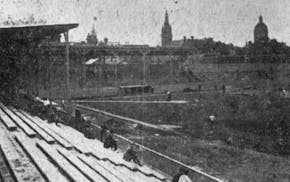Dr. Kathleen Jordan pulled a diversion from her physician's bag of tricks to test thousands of southwestern Minnesota school kids for tuberculosis from 1930 into the '60s.
She'd ask the kids to imagine they were hunting pheasants or big game on a safari, and as they pointed their right arm's imaginary gun and hollered "Bang!" Jordan would jab their passive left arm.
"Oh, look at the mosquito bite," she'd say, sending kids on their way — the Mantoux test completed.
As a field survey physician in Chippewa, Lac qui Parle, Renville and Yellow Medicine counties, Jordan realized how nervous children might be about having a tiny bit of the TB germ injected between skin layers in their forearms.
"Many days she tested 600 to 700 school children and did it almost playfully, short-circuiting the youngsters' fears," Associated Press reporter Gale Tollin wrote in 1982. The kids, he wrote, "carried imaginary ducks or pheasants instead of tears as they returned to class."
By the time Jordan died in 1993 at age 92, she'd won praise for greatly reducing TB cases across Minnesota in the days before the antibiotic streptomycin, along with other drugs and enhanced X-rays, turned the tables on the once-dreaded scourge.
Her pioneering TB work hasn't been forgotten. Carol and Linda Heen, sisters who live in Maynard, Minn., and others in southwestern Minnesota have launched the Dr. Kathleen Jordan Project, culminating this month with a series of exhibits and lectures in Granite Falls.
"It's an incredibly important story that's never been teed up publicly like this," said Carol, adding that the displays will later go to museums and hospital lobbies. "We felt we had an obligation to tell her story because if it wasn't captured and told, it would never be found again."
Carol, 75, can still remember Jordan employing the safari distraction at her tiny country school in Hanley Falls nearly 70 years ago, when she was in third grade.
"I shot a tiger," she said. The doctor "had a magical human touch, a gift that calmly invited total trust."
The daughter of missionaries, Kathleen Boyt Smith was born in England in 1901 and grew up in Algeria, where her parents ran a school for orphan boys. She spoke both English and French and learned to value work that helped the public good.
She graduated from Ohio Wesleyan University in 1923 and earned her medical degree in 1929 at Western Reserve University in Cleveland. While in medical school, she was thought to have contracted TB and took time out to restore her health at Trudeau Sanatorium in Saranac Lake, N.Y.
"The doctors didn't find much," she said later. "I stayed briefly — but long enough to meet a young Dr. Jordan."
Dr. Lewis Jordan, a World War I veteran and TB survivor, met Kathleen Smith while working on the sanatorium staff. He went to Minnesota in 1927 for a job at the Southwestern Sanatorium in Worthington, and two years later moved to Granite Falls to become superintendent and medical director at Riverside Sanatorium. All 15 of Minnesota's tuberculosis hospitals in the 1930s have long since closed.
"In the '30s, Lewis was caring for the sickest of the sick while Kathleen was in the field trying to slow the spread of TB," Linda Heen said.
It's staggering to paint their story with numbers. Kathleen tested 18,000 pupils in 240 schools every two years — using contact tracing, isolation and treatment to shrink the percentage of school children in the four counties reacting to tuberculin from nearly 14% in 1930 to about 2% by 1946.
A 1950 follow-up study showed those numbers dropping from 30.5% to nearly 4% at a Clara City parochial school, while in Fairfax the number of students with TB fell from about 21% to 2%.
All told, Kathleen is credited with testing 1.5 million school children across Minnesota as part of Christmas Seals program that continued into the late 1950s. Those numbers come from a 2022 blog post by Mary Krugerud, an expert on Minnesota sanatoriums who lives in Hutchinson and wrote the book "Interrupted Lives: The History of Tuberculosis in Minnesota."
If the forearm tests left raised reddened patches, confirming TB exposure, the infected students headed to Lewis' sanatorium, where he'd read the X-rays. The Jordans, who lived at the Granite Falls sanatorium, had no children — possibly because of fertility issues linked to their TB cases, Carol Heen said.
The Heen sisters consider themselves "Kathie's kids," as did the thousands of other students she tested. Carol spoke this summer at a senior banquet in Granite Falls, where many of the attendees recalled Kathleen's imaginary safari tactic.
Kathleen Jordan "probably did more tuberculin testing than any other living person," wrote Dr. J. Arthur Myers in his 1949 book "Invited and Conquered." Myers, a University of Minnesota professor who hired Kathleen in 1930 when he ran the Minnesota Public Health Association, wrote that her "splendid pioneer work … was responsible in no small way for the rapid decrease in the incidence of tuberculosis" in Minnesota.
The Mantoux tests became an effective weapon in the battle to slow TB, but reluctant parents first needed to be convinced to have their kids tested. Resorting to bribery to achieve their goals, Kathleen offered to perform school physicals for free if half their kids signed up for TB tests.
"By 1963, the formidable Jordans had finally worked themselves out of a job," wrote Krugerud.
Last year, there were only 160 confirmed TB cases in Minnesota. Annual deaths from the disease averaged fewer than seven statewide from 2018 to 2022, compared with the state record of 2,543 TB deaths in 1918.
Lewis opened a clinic in Granite Falls, following up with his TB patients. After he died in 1965, Kathleen headed to Mississippi to teach school during the heated racial turmoil of the era. They're buried side by side at Granite Falls City Cemetery.
"Kathleen was not only a brilliant physician," Carol Heen said. "In many ways, she was enlightened about helping humanity in any way she could."
Curt Brown's tales about Minnesota's history appear every other Sunday. Readers can send him ideas and suggestions at mnhistory@startribune.com. His latest book looks at 1918 Minnesota, when flu, war and fires converged: strib.mn/MN1918.
Man charged with murder in January death of Jordan woman

Celebrity Wolves fans spotted at game 3

A history buff's quest to mark St. Paul's 'pillbox' ballpark
Prostate experts see familiar scenario in Biden's cancer diagnosis

